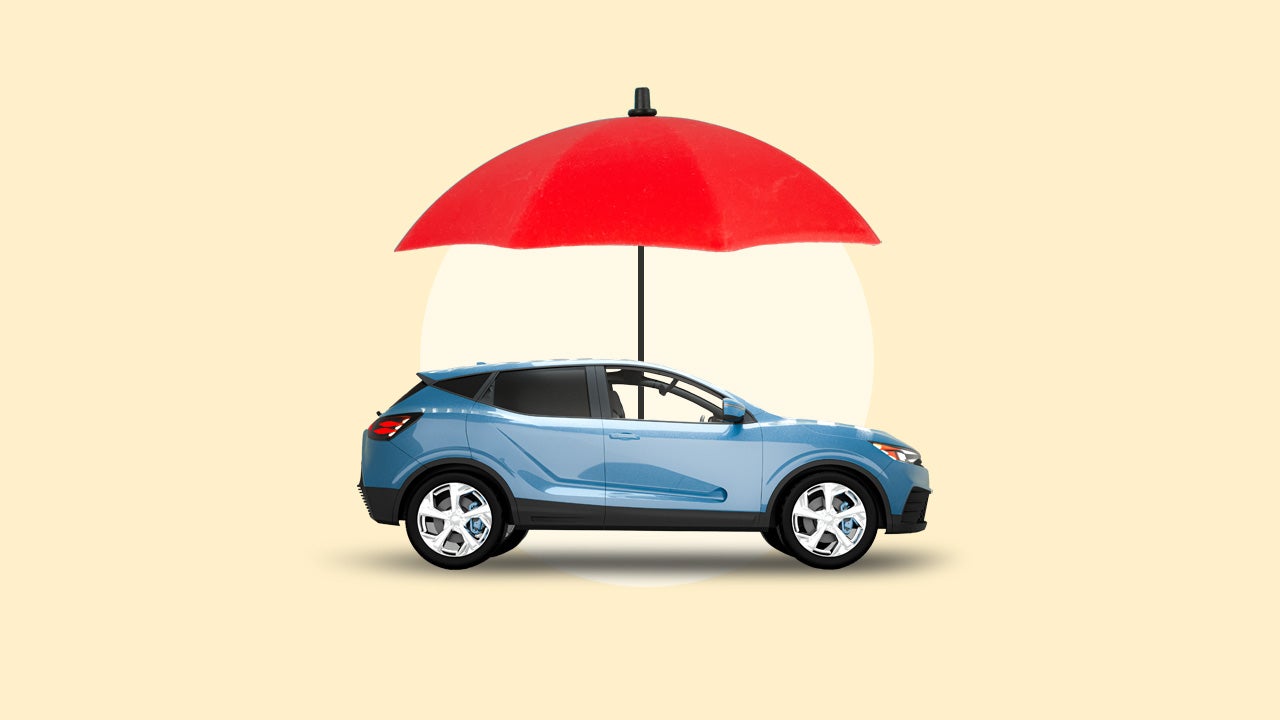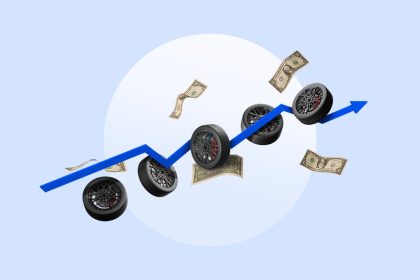Finding the best car insurance can be tricky, especially when you realize that what’s best for one driver may not be the best for another. In general, it’s best to look for companies that offer extensive coverage options while maintaining a high level of customer satisfaction and a solid financial strength rating. Depending on your needs, of course, priorities can shift. Some drivers may need an insurer specialized in high-risk drivers, while others may want one that offers customizable coverage for antique cars. With diverse needs in mind, Bankrate’s insurance editorial team analyzed and compared four of the best-performing auto insurance companies: Geico, State Farm, Progressive, and Allstate.
Top car insurance companies compared
When comparing these four companies, our experts considered financial strength, available coverage, digital tools, customer service, average annual rates and more. Our team calculated a Banrkate Score for each company based on its overall performance, with a five being the top score available. Similarly, our team utilized third-party ratings for customer satisfaction and claims satisfaction from J.D. Power. The following table shows these ratings, comparing Allstate vs. State Farm vs. Geico vs. Progressive.
| Company | Bankrate Score | J.D. Power Claims Satisfaction Study | Avg. annual full coverage premium | Avg. annual full coverage premium after speeding ticket | Avg. annual full coverage premium after at-fault accident |
|---|---|---|---|---|---|
| Progressive | 4.4 | 672/1,000 | $2,190 | $2,846 | $3,309 |
| Geico | 4.3 | 692/1,000 | $2,167 | $2,583 | $3,044 |
| State Farm | 4.3 | 710/1,000 | $2,686 | $3,095 | $3,384 |
| Allstate | 3.9 | 691/1,000 | $3,355 | $3,893 | $4,474 |
Progressive: Best for safe drivers
Why we chose it: Progressive offers competitive average rates and has a program that can help safe drivers save money on their deductibles. The Progressive Deductible Savings Bank is an add-on option that can lower a driver’s deductible by $50 every six months they go without filing a claim or having an auto incident. The company also offers driving-based discounts through its telematics program, Snapshot, further rewarding safe drivers. However, Progressive scored in the bottom two for customer claims satisfaction with J.D. Power.
Learn more about Progressive car insurance.
Pros
- Offers a Name Your Price tool for policy customization and budget friendliness
- Offers a wide range of insurance coverage in most parts of the country
Cons
- Does not have as many local agents or locations as some competitors
- Scored second-to-last in the 2024 J.D. Power U.S. Auto Claims Satisfaction Study
Geico: Best for discounts
Why we chose it: Geico has a history of offering low average rates for many types of drivers. Because the company also provides a robust list of potential discounts, the savings possibilities really start to add up. Geico’s many discounts include military, emergency deployment, telematics, good student, multi-vehicle and more. Geico tends to score well in overall customer satisfaction on J.D. Power surveys, but has struggled with claims satisfaction.
Learn more about Geico car insurance.
Pros
- Has a history of competitive average rates
- Won the 2025 Bankrate Award for Best Auto Insurance Company for High-Risk Drivers
Cons
- Maintains relatively few local agents and locations for in-person service
- Scored below the industry average in the J.D. Power 2024 U.S. Auto Claims Satisfaction Study
State Farm: Best for claims handling
Why we chose it: State Farm scored in the top handful of companies for customer claims satisfaction in the J.D. Power report. The company also scored above the industry average for overall customer satisfaction in every region of the J.D. Power U.S. Auto Claims Satisfaction Study. Not only does the company have high claims and overall satisfaction, but its digital tools are well-liked, and it employs over 19,000 live agents throughout the country.
Learn more about State Farm car insurance.
Pros
- Maintains one of the largest networks of local agents and locations for in-person service
- Won the 2025 Bankrate Award for Best Auto Insurance Company for Safe Drivers
Cons
- Drivers with DUI convictions may be denied coverage
- Gap insurance is not offered as an endorsement
Allstate: Best for new and young drivers
Why we chose it: Allstate offers a driver training program, teenSMART, designed to help young drivers reduce their risks of an auto incident. The company also offers discounts for good students and safe drivers, further offering a telematics program that can actively monitor and reward safe driving habits. Allstate also provides a list of recommendations and discounts that could further help with lowering the rates of young drivers.
Learn more about Allstate car insurance.
Pros
- Has several policy endorsements available for customization, including rideshare coverage, accident forgiveness and extended vehicle care
- Offers multiple ways to save money by driving safely
Cons
- May have less competitive rates than alternatives
- Scored below average in several regions of the 2025 J.D. Power Auto Insurance Study
Which company is best: Allstate vs. State Farm vs. Geico vs. Progressive
Which of the above companies is best for you will depend on several personal rating factors, including your coverage needs. When considering Progressive vs. Geico vs. Allstate vs. State Farm, each company offers different perks and drawbacks, with none being unilaterally the best.
If you are simply looking for the most affordable car insurance, you can request free quotes from each. However, it’s essential to make sure the coverage you purchase doesn’t just fit your budget, but also meets your needs. If you park your car regularly in an area with high vandalism, for instance, it might be wise to consider comprehensive coverage, even though it will increase your premium. Car insurance is about protecting your financial safety long-term, and so it can be complicated to consider how the up-front cost of premiums balances out. In general, you’ll want your coverage to match the risks you face.
Frequently asked questions
Methodology
Bankrate utilizes Quadrant Information Services to analyze August 2025 rates for all ZIP codes and carriers in all 50 states and Washington, D.C. Rates are weighted based on the population density in each geographic region. Quoted rates are based on a single, 40-year-old male and female driver with a clean driving record, good credit and the following full coverage limits:
- $100,000 bodily injury liability per person
- $300,000 bodily injury liability per accident
- $50,000 property damage liability per accident
- $100,000 uninsured motorist bodily injury per person
- $300,000 uninsured motorist bodily injury per accident
- $500 collision deductible
- $500 comprehensive deductible
To determine minimum coverage limits, Bankrate used minimum coverage that meets each state’s requirements. Our base profile drivers own a 2023 Toyota Camry, commute five days a week and drive 12,000 miles annually. Bundling and paperless billing discounts are applied.
These are sample rates and should only be used for comparative purposes. Your quotes will differ.
If otherwise specified, the base profile has been modified with the following driver characteristics:
Bankrate Scores
Our 2025 Bankrate Score for auto insurance considers key variables that our insurance editorial team determined impact policyholders’ experiences with an insurance company. These factors include a robust assessment of each company’s cost of coverage, product availability, financial strength ratings, online capabilities and customer and claims support accessibility. We grouped these factors into three essential categories — cost and ratings, coverage and savings, and support — which we then weighted in a tiered approach.
Each category was assigned a metric to determine performance, and the weighted sum adds up to a company’s total Bankrate Score — out of 5 points. Our scoring model provides a comprehensive view, indicating when companies excel across several key areas and highlighting where they fall short.
- Tier 1 (Cost & ratings): To determine how well auto insurance companies satisfy these priorities, our team analyzed quoted premiums from Quadrant Information Services (if available), as well as any of the latest third-party agency ratings from J.D. Power, AM Best, Demotech and the National Association of Insurance Commissioners (NAIC).
- Tier 2 (Coverage & savings): We assessed companies’ coverage options and availability to help policyholders find a provider that balances cost with coverage. Additionally, we evaluated the discount options listed on each company’s website.
- Tier 3 (Support): To encompass the many ways an auto insurance company can support policyholders, we analyzed avenues of customer accessibility along with community support. This analysis incorporated additional financial strength ratings from S&P and Moody’s and factored in a company’s corporate sustainability efforts.
Why we ask for feedback
Your feedback helps us improve our content and services. It takes less than a minute to
complete.
Your responses are anonymous and will only be used for improving our website.
Help us improve our content
Read the full article here
















